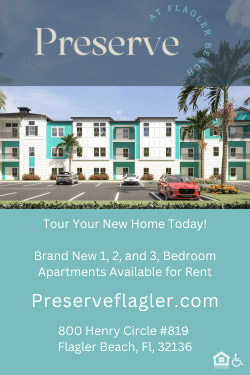
When the Flagler Beach City Commission got its first look at the redesigned A-Frame area at the pier last month, it was not impressed. It did not like the “gingerbread,” the overly ornate exterior of the bathrooms, the roofing that could block portions of the iconic “Flagler Beach” on the A-frame roof.
The commission told Moffat & Nichol, the design firm, and Flagler Beach’s JPA (Joseph Pozzuoli Architects) to try again.
The plans submitted last Thursday drew raves, design-wise. But they did not fare better cost-wise. What started as a $1.5 million project has ballooned to $2.8 million, with several design elements that were not part of the original concept as commissioners understood it, including a covered portion of the 4,200-square-foot promenade.
“I can’t get behind a project that has gone so far out of bounds on the money side,” Commissioner Eric Cooley said. “My issue is with the bells and whistles and shiny objects that are all over the plan.”
“I’d like to push forward with this project, but in the same breath,” Commission Chair James Sherman said, “we’ve definitely got to maybe try to see where we can cut some more costs.”
Example: stick to wood, which decays faster and needs more maintenance, instead of composite materials for the Promenade and railing.
City Manager Dale Martin said the bid process could determine lower costs. He cautioned commissioners not to be stuck on design cost estimates, which could come down at bidding. “We do have tools as we go forward with this process,” he said.
Commissioner Spradley preferred not to go that route. He liked the design. He didn’t like the cost. “I hate to ask for the design team to come back yet again, but that might be something that should be considered,” he said, “because that seems to be the one area that we were all in agreement on, is that we need to get that thing closer to the budget.”
His motion to table the project for the second time in four weeks was approved 5-0.
The project is paid for in part with a $745,000 from the Tourist Development Council. The rest is to be drawn from the city’s reserves. It consists of rebuilding the structure under the A-frame into a 2,700 square foot services building, including naturally ventilated and larger bathrooms walled with stone veneer. It includes renovations of the A-frame’s look from beneath, a new breezeway and three slanted roofs on the new structure.
Pozzuoli had met with the mayor and the commissioners to lay out the plans, and on Thursday gave them a brief architecture seminar, putting the project in its local context.
“So mid-century, modern architecture is what you’re looking at,” Pozzuoli said, displaying an image of the 13-room Ridge Manor Motel on State Road 50 in Hernando County, built in 1959 with high hopes of turning Ridge Manor around. The hopes were dashed. The motel is no longer there. “Low-pitched roofs, shed roofs, monument signage, which are proportionally integrated with the architecture beautifully. Our design reflects and pays homage to Old Florida architecture during this mid-century modern phase.”
The service building would have three slanted shed roofs, lowered 3.5 feet, with their pitch also lowered, since Commissioner Rick Belhumeur had complained last month that the higher roofs were blocking the view of the A-Frame. The “Fla.” portion of the roof signage remains blocked from certain perspectives.
“We’re not repairing the A-frame at all. The A-frame is structurally fine. It’s in good condition. What I would like to do is clean it up, though,” Pozzuoli said, such as moving a pipe out of a railing, creating space and using haint blue staining to bring out the architectural detail of the structure. “So the intent is to clean up everything at a pedestrian scale, a human scale, and then rejuvenate the A-frame with the haint blue.”
A breezeway connects to the Promenade to the south. Belhumeur isn’t a fan. He was alone in that regard. He’s not thrilled by the use of space under the A-Frame, and he is especially irritated by the three sloped roofs.
“We’ve got five different roof lines, and each one’s dumping water on the other one, and then the last one dumps water on the wings of the A-frame,” Belhumeur said. “So that just seems to be a lot going on, and having to control that rainwater. We’re trying to save money to be able to have the composite decking. So I don’t know why we need three roof lines or five.” Gutters could resolve that issue, Pozzuoli said.
Commissioners wanted a composite material instead of timber decking for the Promenade decking, railing and stairs. “Composite is expected to cost more, potentially by about 50 percent,” Perdomo, the designer, said. “That’s for the construction costs. The overall life-cycle cost, of course, would be less and lower maintenance, and we understand that composite is preferred by the city.” He recommended keeping both options open.
Perdomo was hoping to get the commission’s approval to go to 60 percent design and complete that by November, with the 100 percent document completed by February 2026. He did not get that go-ahead. Commissioners weren’t interested in moving the design to 60 percent with so many questions unanswered, and the risk of no longer being able to make significant changes at 60 percent. “It does make it very challenging at the 60 percent level to make major changes,” Perdomo said.
Cooley was most critical of the cost increases. Cooley had been dubious about the originally quoted price of $1.5 million, but that was the advertised price. “Along the way, the budget has doubled, or potentially tripled on this,” Cooley said. “I love all the architecture, I love all that stuff. It’s phenomenal. But it’s not what we approved. We approved a project that was originally supposed to cost $1.5 [million]. What we’re looking at is a $4 million structure, I would assume, and that, to me, is not fiscally responsible. That’s almost a bait and switch.”
He reminded the designers that the commission had “recoiled” when the price began to rise, and issued directions for “value engineering.” That did not happen, he said. For example, the Promenade was never supposed to be covered. Nor were the showers. Now they are.
“That is far, far out of line with what the original intent was,” Cooley said. He wants a more “utilitarian” structure in line with its purposes–bathrooms, service space. “It’s not a tourist center,” he said (though in fact it is, next to the beach, the most touristy site in the city.)
“I didn’t realize the cost had gone up that much either,” Commissioner John Cunningham said. “But I do like the design. It’s great.”
This commission has always had Spradley as its Solomon. He reads the room, his colleagues’ concerns especially, sums up the issue, and proposes a way forward.
“I for one see the areas that I was most interested in and concerned with either changed or retained to the present form,” Spradley said. He reached that conclusion after conversations with constituents. He was fine with the second design. He doesn’t mind the slanted roofs. He finds them “pleasing to the eye,” and he prefers to leave that level of detail to the architect.
At the same time, he saw “uniformity” in concerns about costs, leaving the commission with little choice but to ask the designers and the architect to go back to, in this case, the literal drawing board.
![]()





























Doug says
The pier will be a destination for more tourists than locals, so why not have the Tourist Development Council foot the entire bill? Oh wait, that makes too much sense. Let’s tax the residents instead.
Shark says
Why waste any money. It will be gone this hurricane season or the next ones !!!!
Tim says
The more I read the more I think they put the cart before the horse. When ever I priced a job I need a finished plane to give a quote to a customer. Well it’s not there money so no need to be responsible with it . Nice job
Mike says
I remember the old Church St Station build sold bricks with names to generate revenue for the venue. Any thoughts on outside revenue to help defray cost.
Pig Farmer says
How about a different design firm that will listen to what the customer wants?
Frugal says
Seems too expensive! You could build a luxury home for 1.5 million! Looks pretty minimal – why the huge price rag?
Bill eisfeld says
100% against Composit Decking, you can’t walk on it without shoes, Like walking on a Hot Frying Pan.
It sags over time and its more Plastic on the Beach. Wood,Wood,Wood, is the only way to go, and it’s cheaper.
Come on commissioners, lets not get this Wrong!
Peter B says
Glad you like the design Cunningham. 😝 I agree with Pig Farmer. More than one design company makes sense. Put it out to bid Martin!
Kath says
How about (Thinking out side the box ) we have went without a pier for a few years ! So let’s redo bath rooms ,add a few more wash stations, add more shade and benches for people. Just like the shade benches you have now . Add lighting. Do something with the railings . You see older people pull up with their cars , but never get out of their cars .my guess would be to old to get down to the beach. So fix railings, so you can see the beach..(we do have a aging population) give 5 to 10 years ..what is the average age…you’re not putting stores on the pier..so why waste all this money 🤔. 🤔 and just go down to the beach and realize how it is being used. ..you’re worried about storms. Stop the pier do walkways beachside. The people making all these decisions, are not the people 🙄 that will ever go to the beach ⛱️.
Billy says
overprice project!
John O says
The A Frame structure with those huge block letters on the roof is one of the ugliest public buildings I’ve ever seen in a beach town. It matches the ugly motels, restaurants and residences in Flagler beach. We now have a brand new, bright, airy, modern Compass hotel on one side of the road and across the street is this hulking building that looks like a 1960s Walmart. Some Flagler politicians have said they want to keep the “old Florida feel”. That’s code for “We don’t want to spend any money.” As long as that A Frame is in place it will limit any improvement because no modern designs will be compatible with it. And as a practical matter, there is no room for any significant improvement because the building is too close to the sidewalk, which is too close to A1A, which is too close to the water! All you can do at this p
oi
n
t
i
s
t
h
r
o
w
The A Frame building with it’s huge block letters on the roof is one of the ugliest public buildings I’ve ever seen in a beach town. We now have a brand new, modern, airy, bright Compass Hotel and across the street is a hulking structure that looks like a 1960’s Walmart. Some Flagler politicians have stated that they want to keep the “old Florida feel”. That’s code for ” We don’t want to spend any money”. And it shows. As long as that structure is in place it will limit what designs will be compatible with it. And as a practical matter, there is no room for any significant improvements anyway. The A Frame is too close to the sidewalk, the sidewalk is too narrow because it’s too close to A1A, and A1A is too close to the water. The whole beach was a bad design and now they’re stuck with it.
john clabaugh says
my thoughts are definitely go with the composite why get the splinters and the upkeep of timber also since the beach renewal project and the paid parking in areas close to us we seem to be getting a lot more tourist in residence swimming at our beaches. Why not give them a nice area with the new Margaritaville there should be a lot more local taxes to draw from. No sense in doing things half baked do it right the first time get a good 25 years out of it. I will say I am proud of our local officials questioning the cost and design. That’s what we put them there for. It’s a beautiful little town. Let’s try to keep it small and un commercialized.
Kath says
@john o , how dare you talk about flagler that way ! FYI this is and has always been sleepy little beach town . What next bulldoze the main drag ? 🤔 Everone hates the bride & new hotel does not fit , in this community.. I don’t know where you came from, but this isn’t Miami . We like that small town feel.. if you’re so unhappy here sell and move. I’m sure the people in flagler, won’t miss your sorry. Butt. FLAGLER Strong
Big Mike says
Bill need to do some research before putting out a ill-informed post Trex’s Transcend Lineage collection is designed with heat-mitigating technology that reflects sunlight and helps reduce surface temperatures. There are also other composite decking. Today’s high-performance composite decking is designed to stay cooler than traditional wood. It reflects heat with advanced surface technology. Choosing a light color from a heat-resistant composite line is the best way to improve your outdoor deck experience.
Steve says
Always spending to much. Its basis beach A frame with bathrooms. It’s all that has ever been needed. Sun, sand and ocean. You want more go to one of the 1000 other beaches. Please do not ruin it!
Hello, sanity is calling says
A parent told his kids that they were going on vacation next year to Florida. Naturally the kids were happy and excited and started to ask are we going to Disney World, Universal Studios, Sea World, Lego Land or the Keys ? The parent looked at them and said Flagler Beach. The kids looked back and asked where is Flager Beach and why ? The parent told them because they are building a new pier. The kids said “ what else do they have rides and other amusement “? The parent said no just a new pier that doesn’t have anything on it which charges you to walk on in a community that floods has no parking and a number of overpriced bad restaurants.
The kids looked with bewilderment and said “oh I heard of this place it’s where the city constantly dumps millions of dollars to rebuild a pier that usually gets destroyed after every hurricane. At that moment the kids said” OH NOW I SEE, WERE GOING TO THE RIPLEY’S BELIEVE IT OR NOT museum.
Mr. Bojangles says
As long as they replace the funky pelican with a good restaurant I couldn’t care less. That place is just awful.
J.o. says
Composite decking has many advantages over wood decking however if you are over budget you usually dont have the resources to take advantage of those advantages. Same with most things in life.
Also the advantage of lifetime savings of maintenance may never be achieved due to the nature of structures built on the coastline shortened lifestyle due to tidal surges and storms.
Therefore seems a bit redundant to try to achieve these advantages if you cant afford them.
I like the A frame building however I dont think it should define Flagler Beach simply because it was built on that spot long ago. I dont think you should ever go against the long term residents wishes on landmarks and I would assume most want it to retain pretty much as it always has been.
I personally would like to see it with the same a frame design and a new standing seam metal roof. Then take the bath structure lightly renovate but no major new structural designs.
New wood board walk wood railing and stairwell.
This could all be done well south of 1.5. Have contractors provid design ideas instead of designers and it will get done on budget.
I love Flagler Beach and will alway live here no matter what gets built.
Ryan B says
To all the people saying the pier will be destroyed next hurricane… the pier was built in 1928, since then Flagler Beach has been hit with 80+ huge storms, including multiple hurricanes. The pier has been destroyed twice. Chances are it’ll last a while.